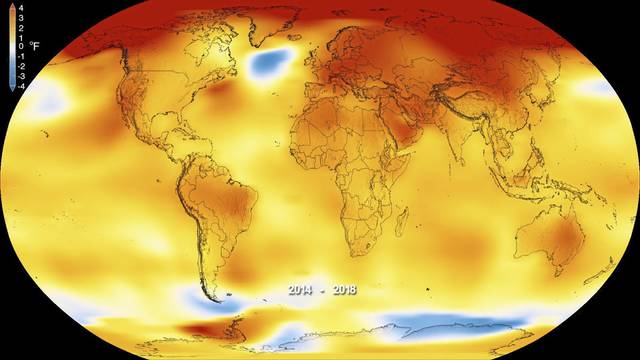https://naviga.triblive.com/news/world/nasa-noaa-2018-fourth-warmest-year-in-more-than-a-century/
NASA, NOAA: 2018 fourth warmest year in more than a century

Earth’s global surface temperatures in 2018 were the fourth warmest since 1880, adding to a long-term global warming trend, NASA officials reported Wednesday in a joint release with the National Oceanic and Atmospheric Administration.
The 2018 annual mean temperature for the contiguous 48 United States was the 14th warmest on record, according to NOAA.
Global temperatures in 2018 were 1.5 degrees Fahrenheit warmer than the 1951 to 1980 mean, according to scientists at NASA’s Goddard Institute for Space Studies in New York.
While last year’s global temperatures ranked behind those of 2016, 2017 and 2015, the past five years collectively were the warmest in the modern record, the scientists noted.
“2018 is yet again an extremely warm year on top of a long-term global warming trend,” said GISS Director Gavin Schmidt.
Since the 1880s, the average global surface temperature has risen about 2 degrees. This warming trend has been driven in large part by increased emissions of carbon dioxide and other greenhouse gases caused by human activities, according to Schmidt.
“The impacts of long-term global warming are already being felt — in coastal flooding, heat waves, intense precipitation and ecosystem change,” he said.
Warming trends are strongest in the Arctic region, where 2018 saw the continued loss of sea ice. Loss from the Greenland and Antarctic ice sheets continued to contribute to the rise in the sea level.
Increasing temperatures can also contribute to longer fire seasons and some extreme weather events, according to Schmidt.
“The impacts of long-term global warming are already being felt — in coastal flooding, heat waves, intense precipitation and ecosystem change,” he said.
NASA’s analyses incorporate temperature measurements from 6,300 weather stations, ship- and buoy-based observations on the sea surface, and data from Antarctic research stations.
NOAA used much of the same raw temperature data in its independent analysis, but with a different baseline period and different interpolation into the earth’s polar and other data-poor regions.
NOAA’s analysis placed 2018 global temperatures at 1.42 degrees above the 20th century average.
Jeff Himler is a Tribune-Review staff writer. You can contact Jeff at 724-836-6622, jhimler@tribweb.com or via Twitter @jhimler_news.
Copyright ©2025— Trib Total Media, LLC (TribLIVE.com)
